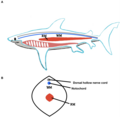Portal:Sharks
Welcome to the shark portal

Sharks are a group of elasmobranch fish characterized by a cartilaginous skeleton, five to seven gill slits on the sides of the head, and pectoral fins that are not fused to the head. Modern sharks are classified within the clade Selachimorpha (or Selachii) and are the sister group to the Batoidea (rays and kin). Some sources extend the term "shark" as an informal category including extinct members of Chondrichthyes (cartilaginous fish) with a shark-like morphology, such as hybodonts. Shark-like chondrichthyans such as Cladoselache and Doliodus first appeared in the Devonian Period (419–359 million years), though some fossilized chondrichthyan-like scales are as old as the Late Ordovician (458–444 million years ago). The oldest confirmed modern sharks (selachimorphs) are known from the Early Jurassic, about 200 million years ago, though records of true sharks may extend back as far as the Permian.
Sharks range in size from the small dwarf lanternshark (Etmopterus perryi), a deep sea species that is only 17 centimetres (6.7 in) in length, to the whale shark (Rhincodon typus), the largest fish in the world, which reaches approximately 12 metres (40 ft) in length. They are found in all seas and are common to depths up to 2,000 metres (6,600 ft). They generally do not live in freshwater, although there are a few known exceptions, such as the bull shark and the river shark, which can be found in both seawater and freshwater. Sharks have a covering of dermal denticles that protects their skin from damage and parasites in addition to improving their fluid dynamics. They have numerous sets of replaceable teeth.
Several species are apex predators, which are organisms that are at the top of their food chain. Select examples include the tiger shark, blue shark, great white shark, mako shark, thresher shark, and hammerhead shark. (Full article...)
Selected article -
During the day, whitetip reef sharks spend much of their time resting inside caves. Unlike other requiem sharks, which rely on ram ventilation and must constantly swim to breathe, this shark can pump water over its gills and lie still on the bottom. At night, whitetip reef sharks emerge to hunt bony fishes, crustaceans, and octopus in groups, their elongate bodies allowing them to force their way into crevices and holes to extract hidden prey. Individual whitetip reef sharks may stay within a particular area of the reef for months to years, time and again returning to the same shelter. This species is viviparous, in which the developing embryos sustained by a placental connection to their mother. One of the few sharks in which mating has been observed in the wild, receptive female whitetip reef sharks are followed by prospective males, who attempt to grasp her pectoral fin and maneuver the two of them into positions suitable for copulation. Females give birth to 1–6 pups every other year, after a gestation period of 10–13 months.
Whitetip reef sharks are rarely aggressive towards humans, though they may investigate swimmers closely. However, spear fishers are at risk of being bitten by one attempting to steal their catch. This species is caught for food, though there are reports of ciguatera poisoning resulting from its consumption. The International Union for Conservation of Nature (IUCN) has assessed the whitetip reef shark as Near Threatened, noting that its numbers are dwindling due to increasing levels of unregulated fishing activity across its range. The slow reproductive rate and limited habitat preferences of this species renders its populations vulnerable to over-exploitation.
Did you know (auto-generated)

- ... that Timo Meier became the first player in San Jose Sharks franchise history to score five goals in one game when he was 25?
- ... that since 2018, IKEA's stuffed toy shark Blåhaj has become a popular Internet meme and an icon of the online transgender community?
- ... that Alexis Sharkey's last Instagram post before her murder documented her travels to Tulum, Mexico?
- ... that "the Hurricane Shark is real"?
- ... that Hixxy and Sharkey created a schism in the UK rave music scene in 1995?
- ... that the ampullae of Lorenzini enable sharks to sense electric fields?
Categories
Related portals
WikiProjects
Selected picture -

More Did you know? -
- ... that the taillight shark has a gland on its belly that releases clouds of luminescent blue fluid?
- ...that the Jersey Shore shark attacks of 1916 killed four people and inspired Peter Benchley's novel Jaws (1974)?
- ... that the presence of the rare bigeye sand tiger in the Pacific Ocean was first suspected based on teeth recovered from the ocean floor?
- ... that the rough skin of the nursehound was once used as an abrasive called "rubskin", which cost a hundred times more than sandpaper?
- ... that the epaulette shark can survive for an hour without oxygen?
General images
Topics
For additional lists of marine life-related featured articles and good articles see:
Wikimedia
The following Wikimedia Foundation sister projects provide more on this subject:
-
Commons
Free media repository -
Wikibooks
Free textbooks and manuals -
Wikidata
Free knowledge base -
Wikinews
Free-content news -
Wikiquote
Collection of quotations -
Wikisource
Free-content library -
Wikispecies
Directory of species -
Wikiversity
Free learning tools -
Wiktionary
Dictionary and thesaurus















































